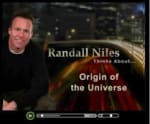Many Worlds Hypothesis

Many Worlds Hypothesis
Alexander Vilenkin, author of Many Worlds in One: The Search for Other Universes, notes that, “For most physicists this was too much to take. A singular jump-starting of the universe looked like a divine intervention, for which they thought there should be no place in physical theory.” Vilenkin must have included himself among those physicists, because in his 2006 treatise he proposed that throughout the inflationary period of the big bang an infinite number of “island universes” formed. Our location among these universes is merely a speck within one of these islands. I find his claim that we have an infinite number of multiple clones of ourselves throughout this vast multiverse both fascinating and absurd.
-
A striking consequence of the new picture of the world is that there should be an infinity of regions with histories absolutely identical to ours. Yes, dear reader, scores of your duplicates are now holding copies of this book. They live on planets exactly like our Earth, with all its mountains, cities, trees, and butterflies. The earths revolve around perfect copies of our Sun, and each sun belongs to a grand spiral galaxy – an exact replica of our Milky Way.1
Many Worlds Hypothesis – Objections
Unfortunately, Vilenkin’s views are fatally flawed from the outset. The concept of infinity only has valid application in mathematics; it does not correspond to any real world number. Physicists recognize this, and while they find it a useful mathematical tool, they fully realize that it has no basis in reality. In fact, the process of renormalization arose in quantum electrodynamics precisely because scientists could not make sense of an actual infinite. During renormalization, infinities convert back to rational numbers.
Vilenkin’s arguments, based on the necessity of an actual infinite, should cause one to question his conclusions. In 1610 Johannes Kepler, and later in 1823, Heinrich Wilhelm Olbers, observed that the night sky should actually remain brightly lit if the universe is infinite. Since, in an infinite universe, every line of sight will eventually reach a star, and brightness does not depend on distance, we should see light emanating from stars throughout the entire sky. We should see a brilliantly illuminated night sky, but we do not. This problem became known as Olbers’ Paradox, and it provides a devastating critique of the concept of an infinite universe.
Many Worlds Hypothesis – The Implications
Vilenkin’s model, while presenting a multiverse that expands eternally along a positive arrow of time, does not imply a situation that has always been eternal. Vilenkin states that, “The conclusion is that past-eternal inflation without a beginning is impossible.”2 However, this presents a potential philosophical problem with Vilenkin’s conclusions. Christian philosopher William Lane Craig points out that:
-
Vilenkin … seems to presuppose a static theory of time or, as it is sometimes called, four-dimensionalism or spacetime realism, according to which all spacetime points, whether past, present, or future, are equally real. For if temporal becoming is an objective feature of reality, as I have argued in my Time and Eternity (Crossway, 2001), then the global future is potentially infinite only, and future Big Bangs do not in any sense exist. If there is a global tide of becoming, then there is no actually infinite collection of Big Bangs after all.3
Many Worlds Hypothesis – Poor Logic
While Vilenkin admits to a beginning, his explanation of that beginning also has its flaws. Vilenkin writes:
-
The concept of a universe materializing out of nothing boggles the mind. What exactly is meant by “nothing”? If this “nothing” could tunnel into something, what could have caused the primary tunneling event?… The initial state prior to the tunneling is… no universe at all. There is no matter and no space in this very peculiar state. Also, there is no time.4
-
And yet, the state of “nothing” cannot be identified with absolute nothingness. The tunneling is described by the laws of quantum mechanics, and thus “nothing” should be subjected to these laws. The laws of physics must have existed, even though there was no universe.5
-
Vilenkin goes on to state that:
If there was nothing before the universe popped out, then what could have caused the tunneling? Remarkably, the answer is that no cause is required. In classical physics, causality dictates what happens from one moment to the next, but in quantum mechanics the behavior of physical objects is inherently unpredictable and some quantum processes have no cause at all.6

